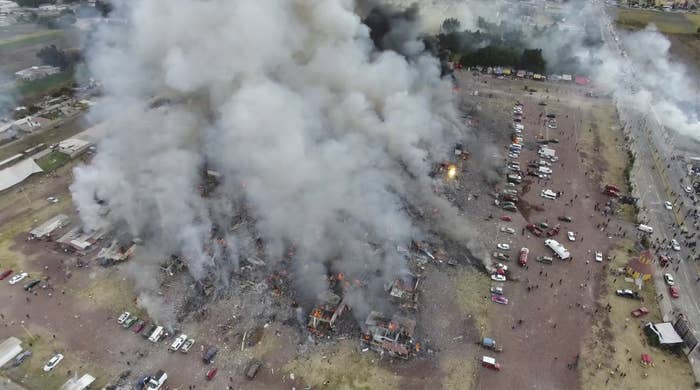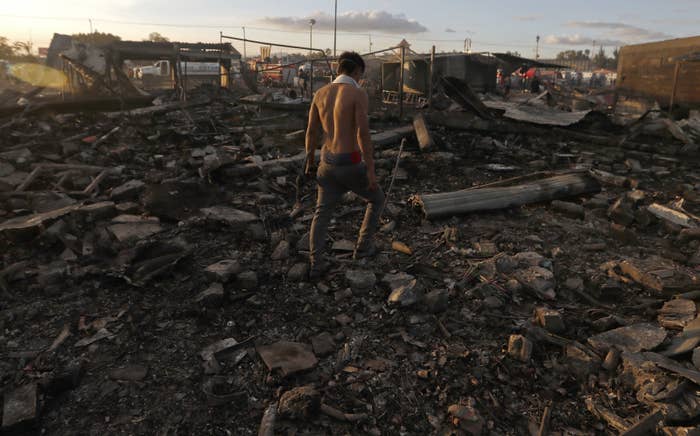
TULTEPEC, Mexico — Dazed people curled their fingers through the chain link fence around a local fireworks market Wednesday as they waited for the latest list of dead and injured. One of them, Rosario Barrios, had spent the night racing to more than a dozen hospitals searching for her mother-in-law, but still there was no trace.
A day earlier, a series of explosions leveled the popular San Pablito market in Tultepec, killing at least 32 people and injuring 72 others, including several children who are being transferred to a specialized hospital in Galveston, Texas.
“The earth rose up and the house began to move from side to side,” said Francisco, a neighbor who was washing dishes about 300 meters away from the market when it erupted in flames. “There were pieces of flesh in the middle of all the smoke,” he added.
The exact cause of the explosion is still under investigation. An eyewitness video showed a billowing plume of smoke spreading across the open-air market, which was brimming with fireworks like Roman candles and firecrackers in anticipation of Christmas and New Year’s Eve. A chain reaction of bright orange flashes punctured the charcoal cloud.
This fire is all too common here: Tultepec’s fireworks market has been scarred by tragedies. In 2005, an explosion ripped through its stalls, injuring dozens of people and flattening hundreds of stalls. In 1998, a blast at a clandestine fireworks factory left at least six people dead and more than 150 houses damaged.
So when people found out about the fire on Tuesday, many here asked: again?
Tultepec, a town of 131,000 on the outskirts of Mexico City, is known as the country’s capital of pyrotechnics. According to a 2013 study, 60% of Tultepec's residents are involved in the industry. Many of the town’s businesses are family-owned and operate out of small warehouses.

“That is the town’s idiosyncrasy,” Jesus Pacheco, chief of the State of Mexico police rescue team, told BuzzFeed News while standing outside the market. He said that when he arrived at the market 30 minutes after the explosion on Tuesday, injured people whose clothes had been burned off were carrying out their relatives. Still, he said, “It will be very hard for people to stop using fireworks.”
Even as people were being rushed off to nearby hospitals after the blasts, residents in Tultepec were setting off fireworks at local parties, several people at the scene Wednesday morning told BuzzFeed News.
Across Mexico, some 40,000 families profit directly from the sale of pyrotechnics, a staple at churches in the staunchly Catholic country, the 2013 study revealed.
“How is it possible that this has happened three times and these same people have experienced it firsthand? People here have shed their fear. It’s about the money,” said Francisco, who did not want his last name published for fear of retaliation by those who control the local fireworks industry.
The various pyrotechnics sold at the market range from 5 cents to $7, according to people whose relatives worked there. But there is so much demand this time of year that, it is still a “great business,” said Angel Solano, who was leaning against the wire fence Wednesday morning. Like many residents here, most members of Solano’s family work in the fireworks industry — even after his uncle’s face was burned critically when his firework factories exploded. “They don’t know how to do anything else,” said Solano.
Solano’s wife, Ilse Guzman, stood nearby, waiting for news of her friend, who worked at one of the 300 stalls in the market. Guzman said that she wants to move away from Tultepec, where most residents stock fireworks in their homes or small factories throughout the year to sell in December.
“We are sitting on a time bomb,” she added.
Nearly half of the residents here live in moderate to extreme poverty, according to a 2010 report by the National Council on the Evaluation of Social Development Policy. The 9 percent of the town who fit the latter category are unable to properly feed themselves, even if they spend all of their income solely on food. Forty-nine percent of residents do not have access to medical services. None of the schools in the municipality offer job-training programs.
Residents in Tultepec have been making and selling fireworks for two centuries, passing on their particular chemical formulas between generations like a family jewel. In the 19th century, artisans here would make the gunpowder for their creations out of ash from nearby volcanoes.
The explosives are produced and decorated by hand, often in small, clandestine warehouses, unregistered with local authorities. They are sold throughout the town, but the industry’s epicenter is the San Pablito market. Some people said stalls in the market were spread out and that each had several fire extinguishers. But others said safety precautions have always been insufficient.
“People here knew that if one [stall] caught on fire, all of them would follow,” said Solano.
Still others who talked to BuzzFeed News believe it wasn’t a matter of oversight by authorities or poor practices by vendors but a divine punishment from God for what they say is the religious country’s frequent use of idols.
Market vendors here expected to sell around 100 tons of pyrotechnic toys between August and the end of the year, according to the Tultepec municipal government. December is especially lucrative, because Mexicans celebrate the Day of the Virgin of Guadalupe, Christmas, and New Year's Eve.
Vendors are allowed by law to sell up to 10 kilos of pyrotechnic toys, or roughly 22 pounds, to each customer.
The smell of gunpowder still tinted the air on Wednesday morning. Thin spirals of smoke were still coming out of mounds of scorched earth as more than 1,000 police officers and soldiers roamed the grounds of the market. But normalcy was quietly returning.
A man walked around onlookers selling single cigarettes. Curious teenagers on bikes stopped to take a look and then went on their way. A middle-aged couple set up a tamale stand, just a few feet from a washed-out canvas sign hanging from the market’s fence listing safety measures to follow "in case of burns.”

